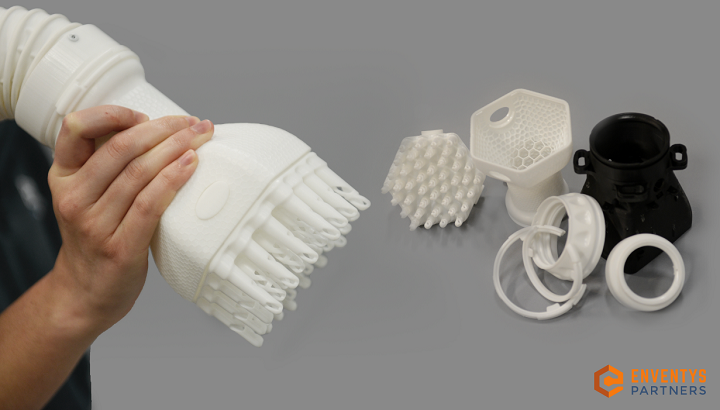Last month, Stratasys (SSYS) completed its acquisition of open SLA startup Origin. Today, the company has announced that Enventys Partners, a full-service, turnkey product launch agency for the AM industry, is using the industrial Origin One 3D printer to create and print end-use treatment devices for head lice. Using Origin’s Programmable PhotoPolymerization (P3) technology from Stratasys should enable a decrease in production costs and lead time, while still offering a high-quality product that doesn’t have the same design issues which plague CNC machining and injection molding technologies.
“The Origin One 3D printer allowed us to make several initial options for our client to choose from and then make tiny tweaks almost in real-time without delaying the project or incurring huge expenses. By prototyping on the same machine that will make the final parts, we had extreme confidence in every piece we were making,” explained TJ Root, the senior design engineer for Enventys Partners.
FloSonix Ventures created a tool that uses a controlled flow of heated air to dehydrate lice eggs on a person’s scalp and hair shaft, which means they can’t continue their lifecycle. The device features embedded smart technology which, according to the website, “ensures that air flow and temperature settings remain accurate and effective.” FloSonix needed to design and fabricate the head lice treatment device so that it had better ergonomics for technicians, and reached out to Enventys Partners for assistance. The company determined that 3D printing would be the best way to go about delivering the product, as it would be less expensive to create the multiple plastic components needed for an estimated 200-300 devices a year with additive technology than with conventional subtractive tooling methods.
In searching for a solution that could create the kind of high-quality product FloSonix needed, Enventys Partners found that while most industrial 3D printers wouldn’t be able to deliver the aesthetic, heat resistant, and mechanical properties that this particular medical device needed, the Origin One 3D printer from Stratasys could.
 The Origin One 3D printer. Image courtesy of Origin.
The Origin One 3D printer. Image courtesy of Origin.“Enventys Partners’ approach to this application is incredibly innovative and an ideal process for any brand taking a complex mid-volume product to market quickly and economically. By using an additive first approach; combining parts, designing custom textures, and taking advantage of Origin One’s material selection and final part quality, they’ve created a playbook for product development using additive manufacturing,” stated Christopher Prucha, the Co-Founder of Origin and now head of the Origin team at Stratasys.
If injection molding or another traditional method of manufacturing had been used to fabricate this medical device, the total cost would have increased, in addition to the number of assembly steps and required parts. But by leveraging the Origin One instead, Enventys Partners had more control and design freedom, and was able to add assembly features, consolidate the number of components, and set the final tuning parameters in order to create a highly accurate product. In addition, most complex medical devices like this one by FloSonix need multiple suppliers, which can introduce several different points of failure into the product life cycle, but 3D printing negates this. Because Enventys Partners used the Origin One to test, validate, and 3D print the device, the company was more confident in the design process and resulting parts.
Origin used several of Henkel’s Loctite 3D printing resins to meet the device requirements for its 3D printed medical devices. FloSonix’s color, temperature, and toughness needs were able to be met in a single device using Loctite 3D 3843, IND403, and MED413, and these materials also offered a good surface finish and high part dimensional stability. Finally, the material can be sterilized, which means that FloSonix was able to replace its one-time-use tips with more sustainable, reusable.
“We are excited to see this product come to market. This application highlights the versatility of 3DP and the multitude of applications that Loctite 3DP materials can serve,” said Ken Kisner, Henkel’s Head of Innovation for 3D printing.
This partnership is a great example of how companies can accomplish both initial design prototyping and end-use manufacturing on just one machine.
If you’d like to learn more about how Enventys Partners used the Origin One 3D Printer and high-performance medical grade materials to economically develop this unique lice removal device, register for this March 31st Stratasys webinar.
Subscribe to Our Email Newsletter
Stay up-to-date on all the latest news from the 3D printing industry and receive information and offers from third party vendors.
You May Also Like
US Army Corps of Engineers Taps Lincoln Electric & Eaton for Largest 3D Printed US Civil Works Part
The Soo Locks sit on the US-Canadian border, enabling maritime travel between Lake Superior and Lake Huron, from which ships can reach the rest of the Great Lakes. Crafts carrying...
Construction 3D Printing CEO Reflects on Being Female in Construction
Natalie Wadley, CEO of ChangeMaker3D, could hear the words of her daughter sitting next to her resounding in her head. “Mum, MUM, you’ve won!” Wadley had just won the prestigious...
Blue Laser-powered M600 3D Printer Launched by Meltio
Founded in 2019 as a joint venture between Additec and Sicnova, metal 3D printer OEM Meltio develops and manufactures high-performance and easy-to-use metal 3D printing solutions that use its patented wire-laser metal...
3D Printed Storage Tanks Cut Material Costs by 25%
In a previous article, “Concrete Dreams: Let’s Print Money, Not Houses,” we discussed how the spotlight on 3D printing homes might be misplaced. Bollards, pedestrian bridges, and concrete tanks could...































